Off the beaten path and uncrowded, the Orlando Wetlands Park is a wildlife lover’s refuge.
From the moment we started walking the paths, we saw startlingly pink spoonbills and snowy egrets with their flowing tufts of mating plumage.
Anhingas showed off their decorated wings as they spread them in the sun. The piercing blue rings around the eyes of the males indicated the birds were searching for mates.

And then there are the two bald eagles with their little ones doing well in the tree tops.
You’d think a park filled with such exquisite and accessible wildlife would be jammed with people. But east of Disney World and west of I-95 at the Titusville exit, the Orlando Wetlands Park seems to be just off the beaten path enough to remain low key. At least for now.
Though out of the way, Orlando Wetlands Park is only 20 minutes off I-95, making it an easy break on an I-95 trip.
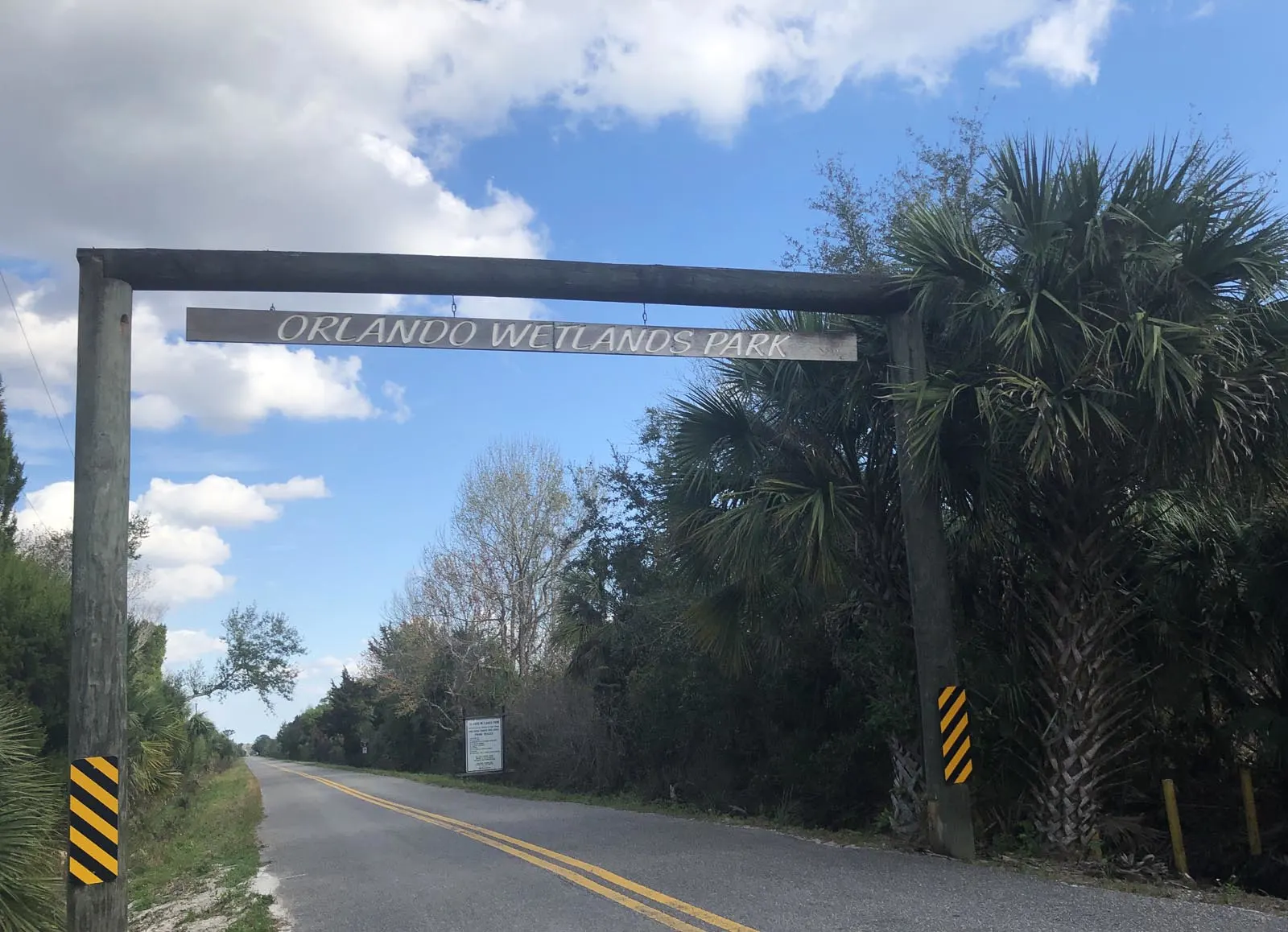
For birders, November through May are the months to visit. You’ll not only see migrating and breeding birds but the weather is more pleasant.
But no matter when you arrive, you are sure to see wildlife in this park that’s becoming more and more popular with people as well as Mother Nature.
To help you explore, there are over 20 miles of hiking trails and sandy roads/trails atop berms.
You can walk, bike or ride a horse to visit many areas of the park. Or, if you prefer, you can sign up near the Education Center to take a free tram tour. They are narrated by volunteers Friday through Sunday.
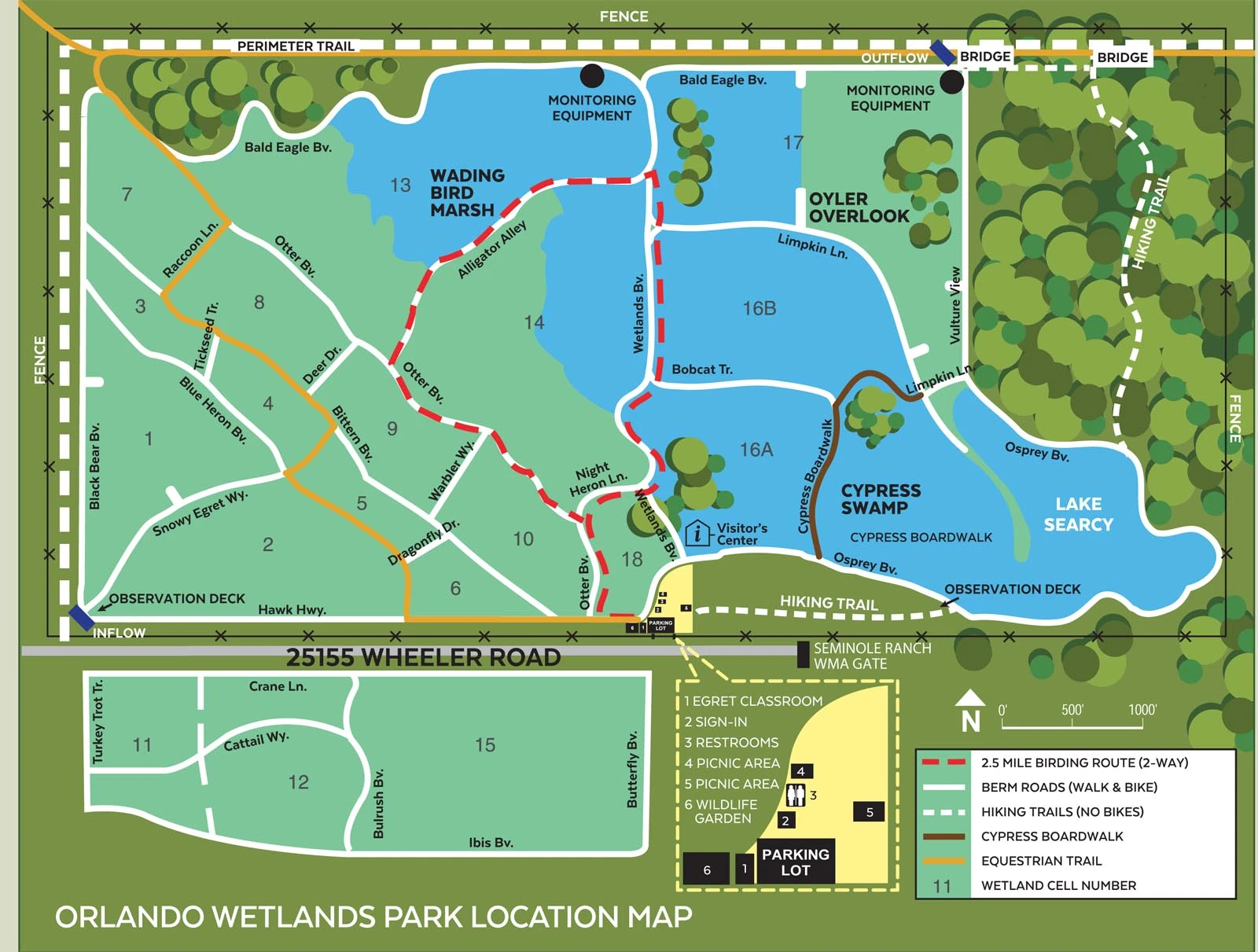
Admittedly, some of the park’s paths are more interesting and better maintained than others. So, on your way from the parking lot, visit the Information Pavilion to pick up a variety of pamphlets including flora and fauna checklists and a park map.
Orlando Wetlands Park boardwalk and tram tour
Because our time here was limited, we asked a staffer what were the best paths for seeing wildlife. She pointed out the 2.5-mile birding route as well as the Cypress Boardwalk.
The boardwalk, which opened in winter of 2022-23, is very popular because it takes you across the marsh to view a cypress dome. As you walk, you have a closeup view of alligators and nesting birds in season so have your cameras and binoculars ready.
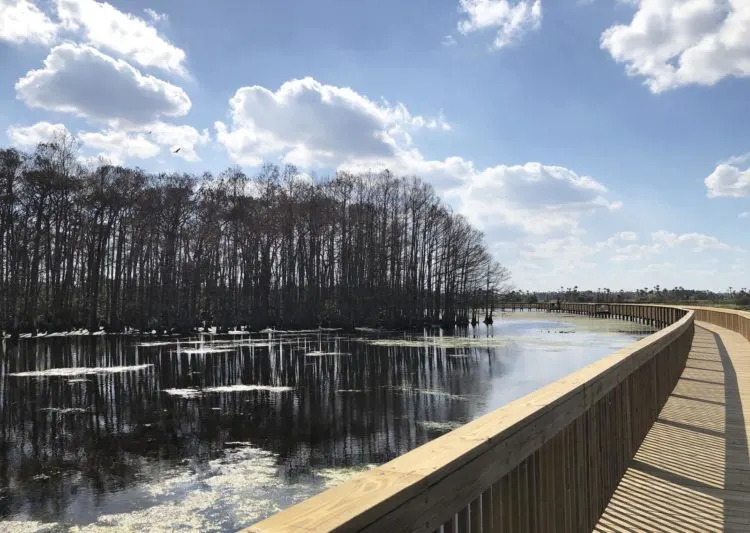
We also thoroughly enjoyed our 1 ½-hour tram tour led by Paul McNamara and Carol Geiger who provided history and context while pointing out and identifying wildlife. Our sightings included great and little blue herons, limpkins (found in no other state), coots, purple gallinules, wood storks, whistling ducks (yes, they whistle) and sandhill cranes plus much more.
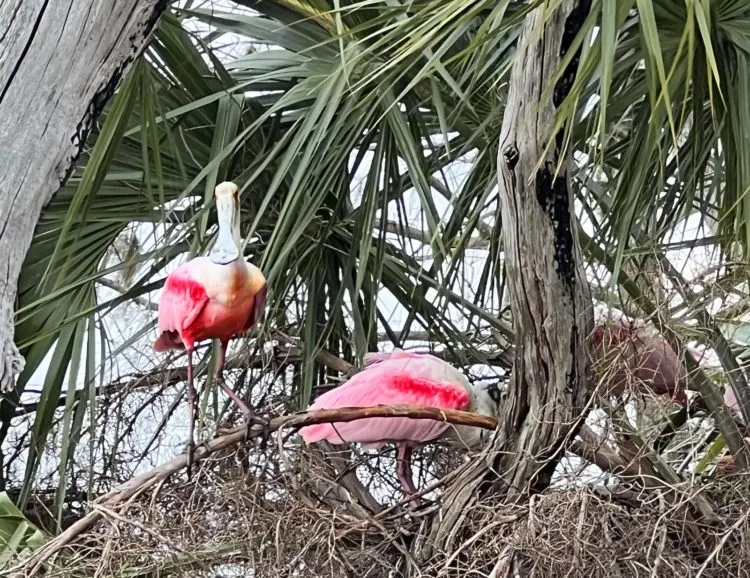
At last count, according to our guides, the park is host to over 100 roseate spoonbills and 1,700 alligators. There also are 200 different species of birds and over 60 types of butterflies.
No wonder the Orlando Wetlands Park is part of the Great Florida Birding and Wildlife Trail.
How the Orlando Wetlands Park came to be
If truth be told, the Orlando Wetlands Park resulted from too much sewage. Yep, sewage.
As Orlando’s population grew in the later part of the last century, so did the amount of waste. As a result, the Iron Bridge Regional Water Reclamation Facility was built in 1979.
As the center produced reclaimed water, it needed wetlands filled with the right plants to filter and remove excess nutrients from the water before it was released back into nature.
That’s when the city purchased over 1,600 acres in nearby Christmas at a cost of over $5 million dollars. And by July 1987, over 1,200 acres of the park’s pasture land had been excavated and planted with 2.3 million wetland plants including 200,000 trees.
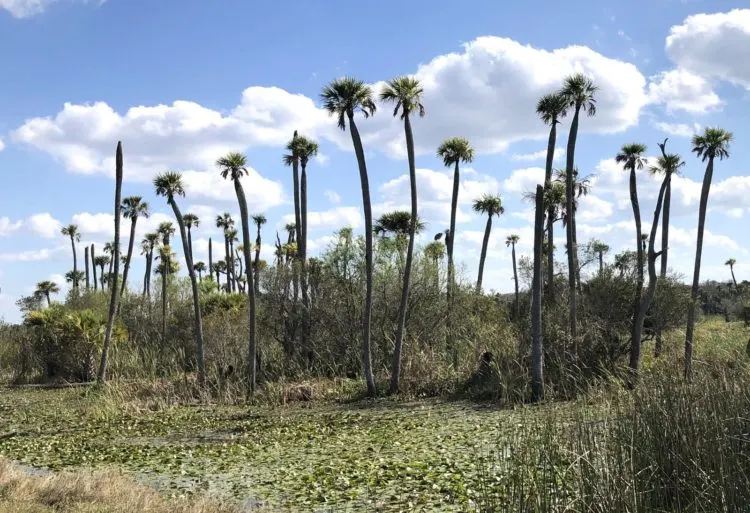
This resulted in the Orlando Wetlands Park comprised of 18 water-filled cells filled with the necessary plants to create three ecological communities: deep marsh, mixed marsh and hardwood swamp.
Over time, the wetlands have attracted all sorts of wildlife that you can view today.
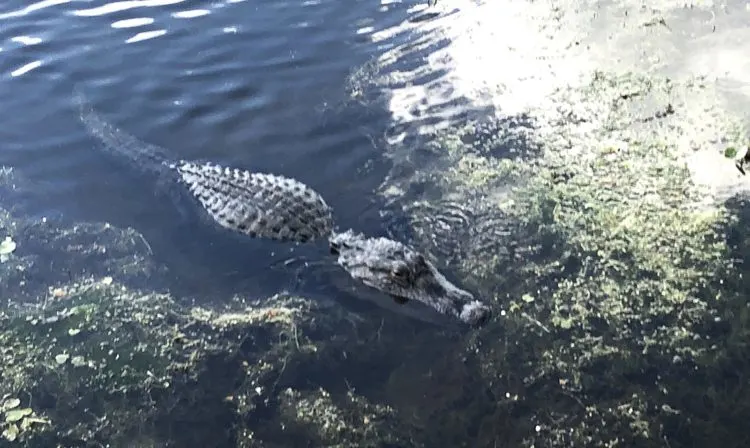
How the Orlando Wetlands purify water
Every day, 16 million gallons of reclaimed water flows 17 miles from Orlando’s Iron Bridge Facility to the Orlando Wetlands Park.
Here, the water flows through the wetland plants. Those plants absorb nutrients such as nitrates and phosphates that they use for their own nourishment.
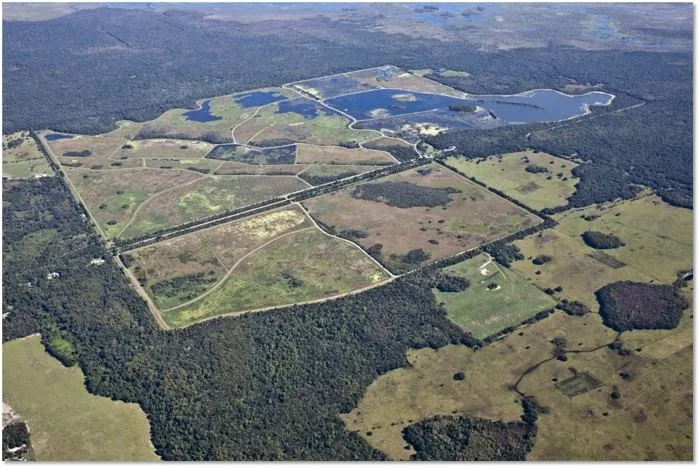
This is important because extra nutrients in the water can encourage algae to grow that, if left unchecked, can lead to those dreaded algal blooms.
Once the water completes its 30-to-40-day journey through the park, it is sampled daily before it is released into canals leading to the St. Johns River. By then, its average phosphorous content is usually less than the water in the river.
Consider the weather
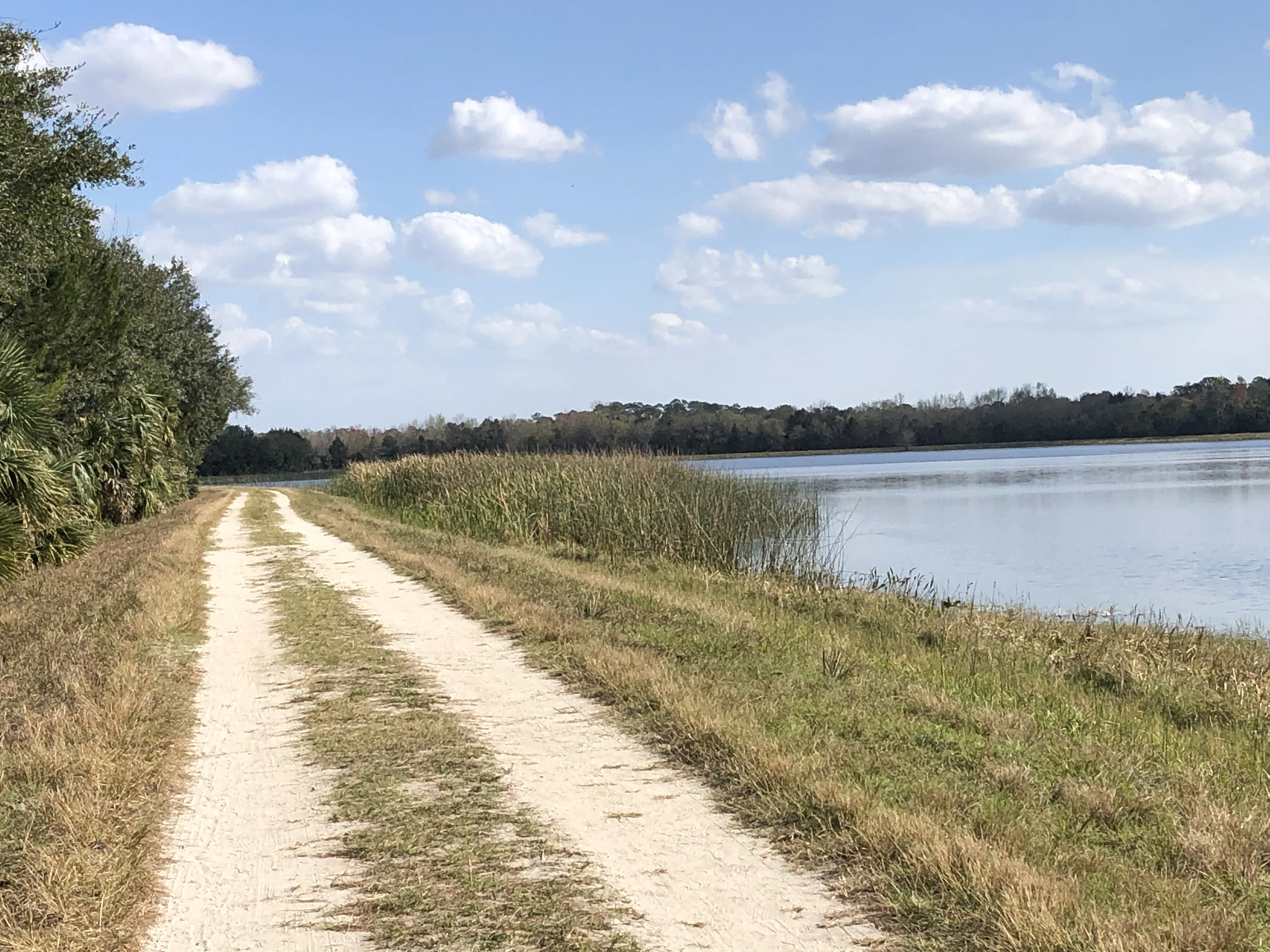
Before you head to this park, find out what the weather will be. It may surprise you.
Seasonal weather in Central Florida can vary from cool to very hot. The park consists mostly of exposed marsh with little-to-no shade or protection.
If you want to walk in a shaded area, there are two hiking trails through the park’s wooded edges.
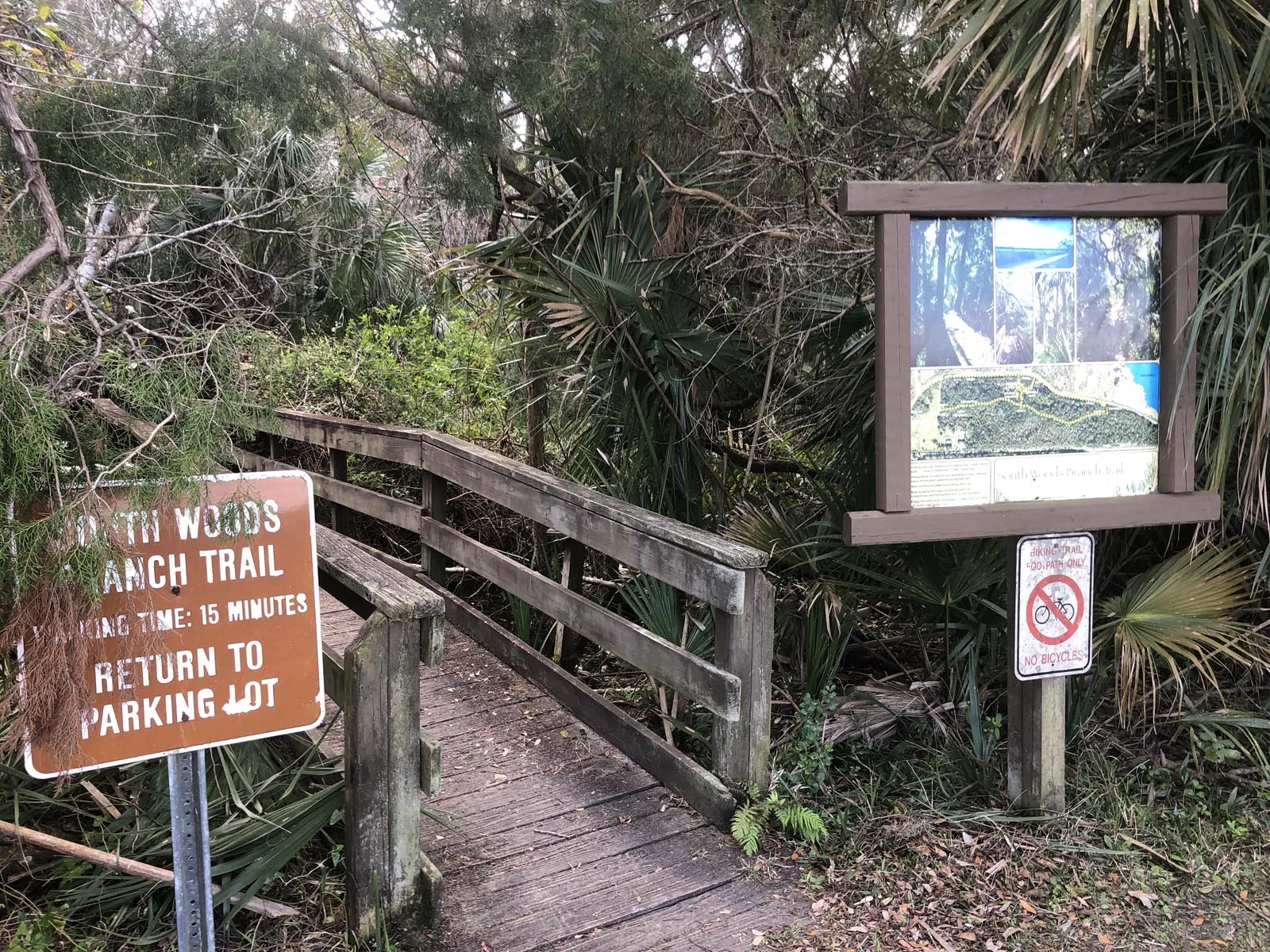
From late spring through summer and early fall, expect hot temperatures with the potential for high humidity, lightning and thunderstorms.
Be sure to wear a hat and sunscreen. You also may need bug spray. And although this is a water purification area, you need to bring your own drinking water.
If you visit Orlando Wetlands Park
Where: Orlando Wetlands Park; 25155 Wheeler Road, Christmas
When: The park is open daily, sunrise to sunset.
Education Center: In this small building off the west parking lot, you can see permanent and seasonal exhibits that include a couple of live small animals, displays and an attractive assortment of items for sale. Plus, you can sign up to take a tram tour.
The center is open Fridays and Saturdays, 9 a.m. to 3 p.m.; Sundays, 9 a.m. to 3 p.m., September through May only. A new, much larger center is under construction and slated to open summer, 2023
Orlando Wetlands Park Tram Tours: September through May, volunteers lead tram tours Fridays through Sundays from 9 a.m. to 3 p.m. The trams hold a maximum of 10 people. Tours are first-come, first-served; no reservations. Sign up at the Education Center to get on the tour list. Subject to weather.
Rambler Tip: Now that the Orlando Wetlands Park is drawing more tourists, the tram tours fill up quickly. If you are interested, be sure to sign in and get your name on the list when you arrive at the park.
Admission and parking: Both are free but parking is limited. There is some overflow parking across the street at the Seminole Ranch Wildlife Management Area lot.
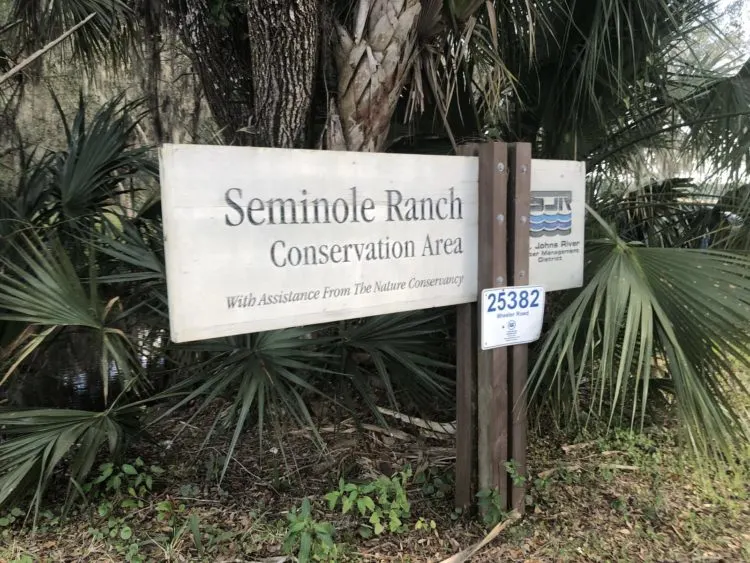
Water and food: There is no food available in the park and there are only very limited options to purchase food in Christmas. You’ll need to plan ahead if you want to bring your own. Soft drinks and bottled water are available for purchase in the Education Center when it is open. And there’s a public drinking fountain with bottle filling station on the east side of the restrooms.
More information: 407-568-1706; park rules
Places to go near Orlando Wetlands Park
Here are a few places in the region Florida Rambler has written about:
Some great hiking trails are found at the Little Big Econ State Forest. This is about 20 minutes north of the Orlando Wetlands Park.
Also a half hour away is excellent kayaking on the Econlockhatchee River.
About 50 minutes away is a community where we’ve enjoyed a weekend, charming historic town, Winter Park.

Deborah Hartz-Seeley is a Master Gardener whose yard is certified as Florida Friendly. With a master’s degree in agricultural journalism, she’s written for the Sun-Sentinel, Miami Herald, The Coastal Star, Cook’s Magazine, Florida Food & Farm and Florida Design. If she’s not out back growing things, you’ll find her wandering a garden path or exploring nature on foot, on a bike or in a kayak.
